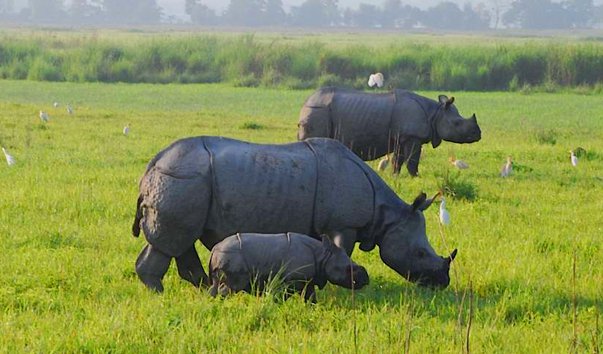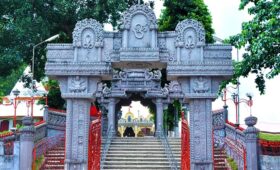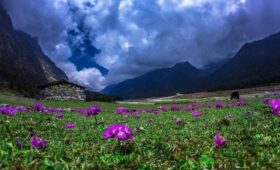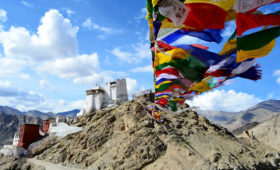Kaziranga National Park in Assam is the world’s largest habitat for the great one-horned rhinos. It is India’s biggest bio-diversity treasure, and a UNESCO’s world heritage site.
The Brahmaputra river basin has bestowed the land of Assam with natural wonders. It has created an ecosystem so diverse around its belt that almost 80% of the flora and fauna that thrives here is unique to this region.When it comes to places to visit in Assam, one of the names always makes its impression. Located on the banks of The Mighty Brahmaputra and at a distance of almost 228 km from Guwahati, lies the Kaziranga National Park.
One of the most diverse forest areas of India, Kaziranga Tourism is famous because of the Great One Horned Rhinoceros. Apart from the Rhinos, Kaziranga has a huge and thriving population of Tigers, Swamp Deer, Leopards, Bears and Elephants.
If you are planning to move on from the regular crowded forest trails of India and see something unique and out of the world, then Kaziranga is the place to be.
Kaziranga is the British project coming to life
In the year 1904, Lord Curzon’s wife visited Assam to see the local population of Rhinoceros but couldn’t find any. Concerned about the dwindling population of The Rhinos, she persuaded her husband to create a safe haven for the local animal population. And this is how the Kaziranga tourism project came to life in the year 1905.
A UNESCO World Heritage Site
Kaziranga Tourism has been declared a world heritage site by UNESCO. Being one of the biggest natural landscapes of North East India, Kaziranga represents the Brahmaputra Valley Floodplains. The uniqueness of this region’s diversity prompted UNESCO to work towards its conservation and make necessary arrangements to stop hunting and poaching.
Today, a number of Kaziranga national park hotels have developed their operations in an eco-friendly way without harming the nature. North East- The land of scenic beauty pays special attention towards the conservation of this forest.
The Local legends behind the name
North East is famous for its many legends. Kaziranga National Park is no exception. It is said that a girl Ranga, from a nearby village, and a boy named Kazi, from Karbi Anglong, fell in love. The local village authorities rejected this union and so the couple decided to run away. They wandered into the forest and no one saw them ever again. Thus the name Kaziranga Forest came into existence.
Another legend says that the sixteenth century Vaisnava saint-scholar, Srimanta Sankardeva, once blessed a childless couple, Kazi and Rangai. As a part of the blessing, they were asked to dig a big pond in the region so that their name would live on.
Although, the reason behind the name of Kaziranga Park could also be because of the abundance of Red Goats found in this region. Kazi in the Karbi language means “goat”, and Rangai means “red”.
Safari Options
Kaziranga National Park has divided its Safari Routes into three distinct zones. These routes are the Western Range, Central Range and Eastern Range. It is recommended to stay near the Central Gate as it is the most convenient among all the Kaziranga National Park locations.
Kaziranga Forest is probably the only national park in India which provides three Safari options. You can take a jeep safari, elephant safari and even a boat ride in the Brahmaputra Marshes as a part of your Kaziranga packages.
A treat for animal lovers
Being a part of Brahmaputra’s marshlands, Kaziranga Forest makes a perfect home to support the population of mammals and birds. Kaziranga National Park animals include 35 species of mammals found here. Kaziranga is also the home to about 500 species of birds. A birding enthusiast will find the greatest treats of their life and enjoy every moment of exploring the park. The population of tigers in Kaziranga goes up to 106, more than any other National Parks in India.
Here are some of the common animals found in the Kaziranga National Park
- One-horned Rhinos
- Bisons
- Tigers
- Gibbons
- Macaques
- Antelopes
- Himalayan Mole
- Gaur
- Sloth Bear
- Indian Porcupine
- Indian Civet
- Indian Mongoose
- Chinese Ferret Badger
Kaziranga is also the home to a thriving bird population, some of which includes
- Spotted Owlet
- Ruddy Shelduck
- Black Headed Ibis
- Spot Billed Ducks
- Greenshank
- Grey Headed Fishing Eagle
- Brown Fish Owl
- Bar Headed Geese
- Lesser Whistling Duck
- Bronzed Winged Jacana
- Greater Cormorant
Most of the Kaziranga National Park Resorts conduct their own package birding and photography tours. The beauty, the greenery and the weather makes Kaziranga counted among the most beautiful places to visit in Assam.
Hoollongapar Gibbon Sanctuary
Hoollongapar Gibbon Sanctuary or Hoolock Gibbon Sanctuary is a special zone in Kaziranga park, created to conserve the unique species of Apes found in India – the Hoolok Gibbon. Their lack of tail makes them distinctly different from other primates and apes. Hooloks can also walk on their legs to a considerable distance.
The Dominance of Hollong Trees is the reason it is named Hoollongapar Sanctuary. It is easy to reach here as Kaziranga National Park resorts arrange for vehicles and permits to explore the sanctuary. This amazing diversity makes Kaziranga one of the best places to visit in North East.
Stay Options in Kaziranga National Park
Stay options in Kaziranga vary between budget stay homes, shared dormitories and luxury five star resorts. You can also ditch the Hotels in Kaziranga and instead go for a local guest house at Kohora or a nearby village.
Best Time to Visit Kaziranga National Park
Kaziranga is very hot and humid during the summers (April – June), and experiences warm days and cold nights in winters (November – January). Apart from this, the rest of the months are not advisable to visit as the region experiences massive floods. November to April is the best time to visit Kaziranga National Park.
How to Reach Kaziranga National Park
Kaziranga National Park’s location is very convenient. The roads are well maintained and regular trains, buses and taxis run between the major areas of interest in Assam.
Flight – LGB Airport Guwahati is at a distance of 5 hours from Kaziranga National Park. A lovely scenic drive takes you all the way to this beautiful heavenly destination
Train – Guwahati Station is connected with the major cities of India. You can find trains from Mumbai, Bangalore, Delhi on daily, weekly and bi-weekly basis.
By Road – Private taxis are available from Guwahati station and airport. A little bargaining will help you find cheaper rates than what you are told. You can also take one of the North East tour packages which include Kaziranga in the itinerary
Regular buses run between Kaziranga and Guwahati (217 KM), Jorhat (96 KM), Nawgaon, Dibrugarh, Tezpur (75 KM) or Tinsukia. These buses drop you at Kohora and from here you need to take a personal ride to reach your destination. Most of the Kaziranga national park hotels are in the proximity of Kohora.
Also, check out our Kaziranga Tour Packages and experience the bliss of Nature with the wildlife display.
Disclaimer: Triptuners India claims no credit for images featured on our blog site unless otherwise noted. All visual content is copyrighted to its respectful owners. We try to link back to original sources whenever possible. If you own the rights to any of the images, and do not wish them to appear on Triptuners India, please contact us and they will be promptly removed. We believe in providing proper attribution to the original author, artist or photographer.




